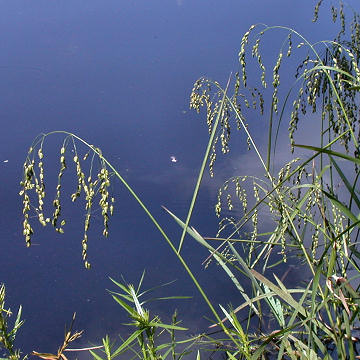

Glyceria canadensis - (image 1 of 4)
Taxonomy
Family: Poaceae
Habitat
Swamps, bogs, wet woods, springy areas.
Associates
Distribution
Newfoundland west to MN, south to NJ and IL.
Morphology
Erect perennial to 1 m; stems solitary or in small tufts. Leaves 3-8 mm wide; ligule 2-6 mm. Inflorescence 10-30 cm long, diffuse, branches nodding with most spikelets borne near the tip; spikelets broadly ovate, 4-8 mm, each with 5-10 flowers; glumes with scarious margins; first glume lanceolate, 1.6-2.4 mm; second glume broadly ovate, about 2.2 mm; lemmas broadly ovate, veins visible but not raised, 2.9-4 mm, margins thin or scarious, not covering the sides of the palea, the tip acute and projecting 0.5 mm past the palea; palea round-obovate; stamens 2.
Notes
Flowers: June
Wetland indicator: Obligate
The common name may come from the superficial resemblance of the spikelets to the tail of a rattlesnake.
References
Gleason, Henry A. and A. Cronquist. 1991. Manual of Vascular Plants of Northeastern United States and Adjacent Canada. Second Ed.
The New York Botanical Garden. Bronx, NY
Swink, F. and G. Wilhelm. 1994. Plants of the Chicago Region.
Indiana Academy of Science. The Morton Arboretum. Lisle, Illinois.
|
Michael Hough © 2010 |